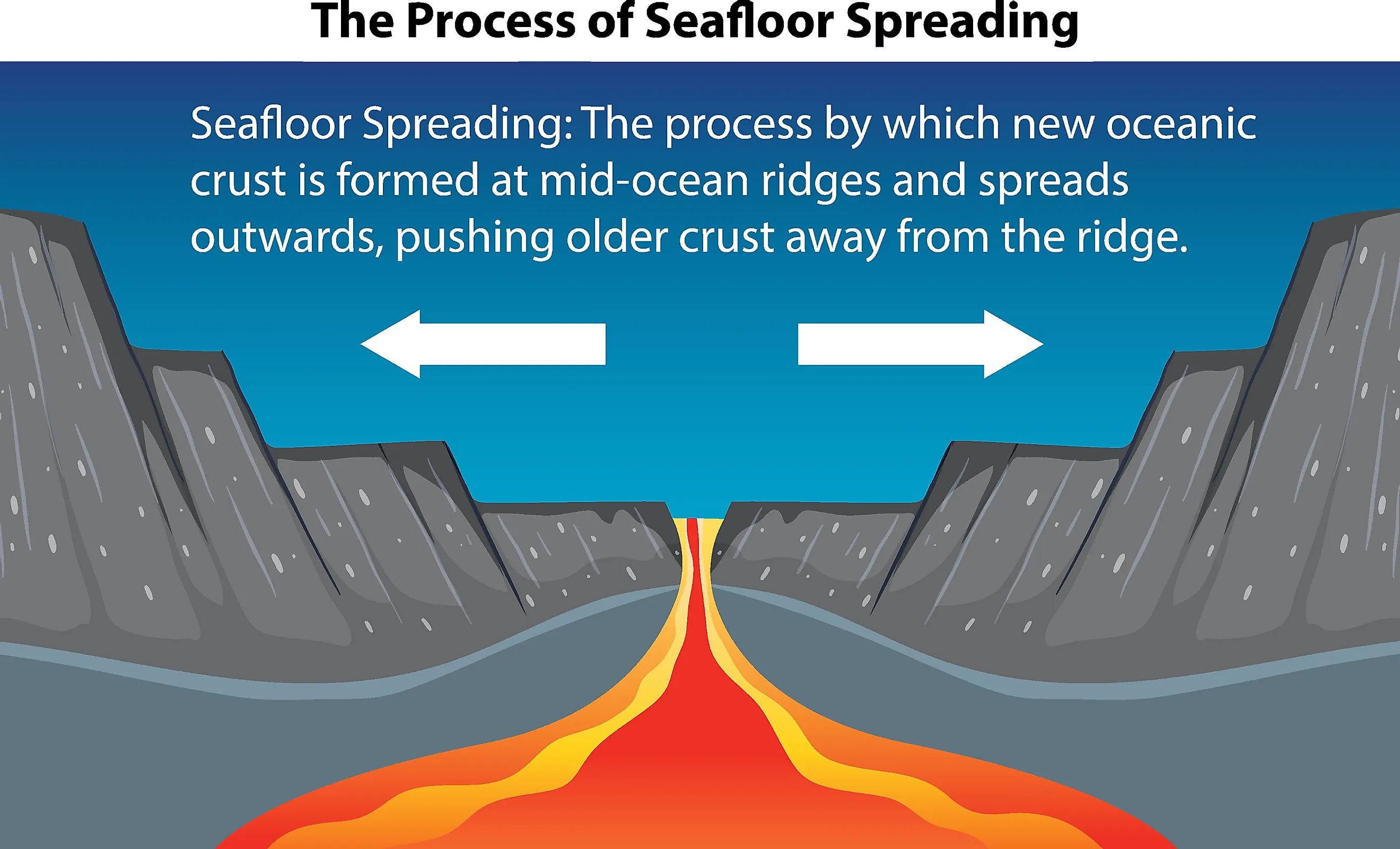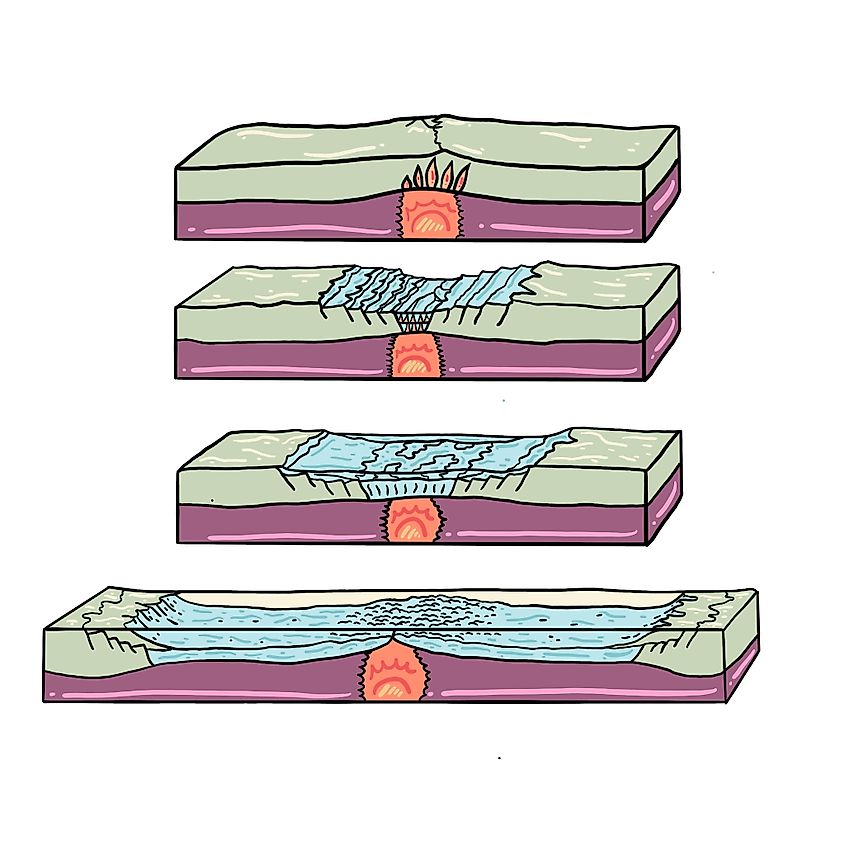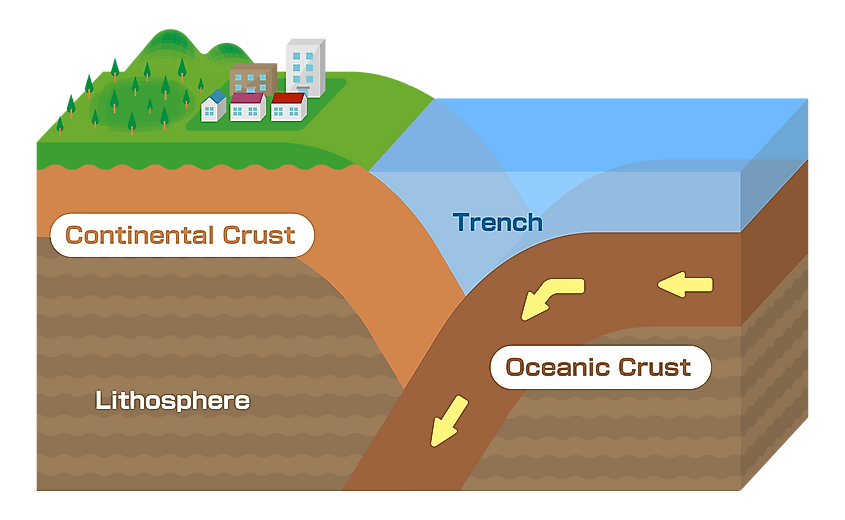
Seafloor Spreading
Also called seafloor spread, seafloor spreading is a geological process by which new oceanic crust forms at mid-ocean ridges through volcanic activities and then slowly moves away from the ridges. Seafloor spreading occurs at divergent boundaries where the tectonic plates move away from each other, resulting in the formation of new seafloor. These divergent boundaries are usually found between oceanic plates as mid-ocean ridges. For example, the Mid-Atlantic Ridge separates the Eurasian Plate from the North American Plate and the African Plate from the South American Plate. Another mid-ocean ridge, the East Pacific Rise, separates the North American, Cocos, Nazca, and Antarctic plates from the Pacific Plate.
However, all mid-ocean ridges do not show consistent seafloor spreading; some are slow-spreading, whereas others are rapidly spreading ridges. It is to be noted that while seafloor spreading creates a new oceanic crust, the old lithospheric material is ‘recycled’ back into the Earth’s mantle at the subduction zones. These two forces balance each other, keeping the shape and diameter of the Earth constant.
Process Of Seafloor Spreading

The concept of seafloor spreading forms an integral part of the modern plate tectonics theory and helps to explain continental drift. The movement of oceanic plates at divergent boundaries leads to the development of fractures in the lithosphere due to tensional stress. Hot basaltic magma from the mantle rises from the fractures at the spreading centers present along the crests of mid-ocean ridges. This hot magma subsequently cools down and hardens to become the new seafloor or oceanic crust primarily composed of basaltic rocks. The newly formed seafloor then slowly moves away from the ridge, and its place is taken by a newer seafloor, and the cycle repeats. In due course, the older rocks move farther away from the spreading centers, whereas the comparatively younger rocks are found close to the spreading centers. On each side of the ridge, the seafloor moves away from the ridge and toward the deep-sea trenches, where the old crust is subducted and recycled back into the mantle.
How Was Seafloor Spreading Discovered?
After the conclusion of World War II, sonar-equipped vessels traveled across the oceans collecting information about the ocean-depth profiles. This survey data was then used to prepare 3D relief maps of the ocean floor. In 1953, Marie Tharp, a well-known American oceanic cartographer, made maps that revealed the existence of the Mid-Atlantic Ridge, an underwater mountain range over 10,000 miles long in the Atlantic Ocean. In 1960, the renowned American geophysicist Harry H. Hess proposed the seafloor spreading hypothesis. Based on Tharp’s discoveries about the deep-ocean floor, Hess hypothesized that along the crests of the mid-ocean ridges, molten material from the Earth’s mantle wells up continuously. This magma is then cooled by the cold seawater, creating a new crust. The crust is then pushed away from the flanks of the mid-ocean ridges, and this material flow is believed to lead to the drifting apart of the continents.

Evidences Of Seafloor Spreading
Harry H. Hess collected many pieces of evidence to support the seafloor spreading theory. This evidence came from proper investigations of the molten material, geomagnetic reversals, seafloor drilling, and the age of the sea floor. Some of the evidences that came up in support of the seafloor spreading theory have been discussed below.
Molten Material
When Hess began ocean mapping, he discovered warm temperatures close to the mid-ocean ridges. He also found that the conditions at the mid-ocean ridges were quite different due to warmer temperatures from other surfaces that were far away from that region. Hess concluded that this warmer temperature was due to hot convection currents that caused the upwelling of magma from the Earth’s interior up the lithosphere. The radioactive energy from the Earth’s core makes the materials in the lower mantle quite warm and less dense, causing them to rise. The materials then flow through the upper mantle and leak through the fractures in the lithospheric plates at the mid-ocean ridges. This is the main reason for warmer temperatures at the mid-ocean ridges.
Seafloor Drilling
The samples which were obtained by seafloor drilling revealed that the oceanic crust, which moved away from the mid-oceanic ridge, was progressively older, while the oceanic crust close to the mid-ocean ridge was comparatively younger. Moreover, the older crust was also quite denser and thicker, while the younger crust was thinner and less dense. The studies also revealed that the oldest known ocean floor is about 200 million years old, indicating that older seafloors have been destroyed by subduction at the deep-sea trenches.
Geomagnetic Reversals
In the 1960s, magnetic surveys of the ocean floor using magnetometers revealed that the basaltic rocks found at the mid-ocean ridges contain magnetic materials which align themselves in the direction of the magnetic field. The paleomagnetic rocks on either side of the mid-ocean ridges showed alternate ‘stripes’ of normal and reversed polarity. This provided clear evidence that the continuous process of seafloor spreading led to the separation of the stripes in a symmetrical pattern.
Significance Of Seafloor Spreading
The process of seafloor spreading is credited with the formation of several new geographical features. It is believed that seafloor spreading led to the formation of the Red Sea due to the movement of the African and Arabian tectonic plates. These two plates are continuously moving and widening the Red Sea. The Niger Delta is also considered to be formed by seafloor spreading due to the westward movement of Africa to its current position.
It has been recorded that the Atlantic Ocean basin is undergoing continuous active separation at the Mid-Atlantic Ridge. However, this ridge is considered a slow-spreading center, as it spreads about 0.8 to 2 inches every year and is characterized by steep cliffs and mountainous regions. The East Pacific Rise is a fast-spreading center that spreads about 3 to 6 inches per year and is characterized by gently sloping gradients. The plates which make up the Pacific Ocean are undergoing subduction along many of their boundaries, leading to volcanic eruptions and earthquakes at the Ring of Fire.
In addition to this, seafloor spreading influences sea level and the carbon cycle. The geologic process also injects greenhouse gases into the atmosphere, in turn influencing the Earth’s climate. Therefore, it is necessary to have proper knowledge of the seafloor spreading theory as it helps us to understand earthquakes, volcanic eruptions, and the creation of several topographical features.











